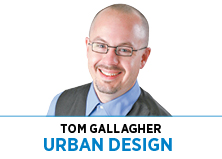Subscriber Benefit
As a subscriber you can listen to articles at work, in the car, or while you work out. Subscribe Now The recent announcement of improvements, both inside and out, to Bankers Life Fieldhouse sparked some interesting discussions regarding public space. Whatever your thoughts might be about the conceptual design of the Indiana Pacers’ new outdoor plaza, we should take advantage of this moment to think deeply about the value of public spaces and what it takes to make outstanding ones.
The recent announcement of improvements, both inside and out, to Bankers Life Fieldhouse sparked some interesting discussions regarding public space. Whatever your thoughts might be about the conceptual design of the Indiana Pacers’ new outdoor plaza, we should take advantage of this moment to think deeply about the value of public spaces and what it takes to make outstanding ones.
First, it’s important to distinguish between open space and public space. Open space is the enemy of great urban places, while public spaces are essential to their vitality. Leaving a location “open”—or without buildings—leaves gaps in the urban fabric that are detrimental to the cohesion and consistency of the urban experience and disruptive to the core economics of urban places. Meanwhile, public spaces are very much a part of the built environment and far from empty. Their roles are powerful and nuanced—street or multi-use trail; river or wildlife corridor; park, playground or plaza. They possess a richness that the term open space doesn’t begin to describe.
With that in mind, Indy has an open-space problem. Out of the 100 original blocks of the Mile Square, almost 50 have significant breaks of half a block or more given over to parking lots or vacant land. On top of this, the 90-foot rights-of-way that form the grid of our urban core exacerbate the feeling of emptiness. We’ve dedicated too much space to private vehicle use and storage with hardly a tree to be found.
Our goal for the public realm downtown should be to fill in the gaps. In this context, we need to earnestly consider when and where new parks, plazas and squares are appropriate. Once we decide to make one, we should set it up for success, lest it go underused and unoccupied.
Success starts with the recognition that parks and plazas have distinctly different roles. Where urban parks offer a green escape from the bustle and brick-and-mortar, plazas present the opportunity to be completely immersed in the best of what urban commotion has to offer.
Keeping our focus on plazas, I suggest that excellent examples share three foundational traits.
First, they have enclosure that makes them feel like an outdoor room. This is Monument Circle’s greatest asset. It is important to note that this element cannot be accomplished by the plaza alone; it requires collaboration with adjacent buildings.
Compare the Circle to the newly completed Lugar Plaza on the south side of the City-County Building. For the size of the Lugar Plaza space, the adjacent structures do not have the height or presence to visually hold the perimeter edge. As this space matures, however, you should begin to see some of the strategies employed—layered stands of trees, in particular—to form the “walls” of the rooms within the plaza.
Next, great plazas must be embracing. They possess a magnetic quality that naturally draws you in and imparts the feeling that all are welcome. This impression starts at the plaza edge. One of the most successful treatments employed at Lugar Plaza is the raised sitting gardens along the southern edge. They simultaneously define the perimeter of the place and invite you to step up into the plaza.
One block north, at City Market plaza, the intent might have been to define a comfortable room internally, but the tall planter edge gives you the impression that you should walk on by.
Drawing people in is especially challenging for sunken plazas. The casual passer-by is less likely to be drawn into the lower-level space unless something compelling is below. Think about how easily people move up to occupy the steps of the Soldiers and Sailors Monument but continue to be challenged by descending to the Canal Walk.
Finally, successful plazas are engaging. Hosting events and programming is important but no substitute for the near-constant and authentic vitality that can be brought organically from a fine grain of shops, cafes and restaurants activating the edge. This—together with a casual, permanent focal point near the middle—creates places to both see and be seen.
In Indy, of course, the Circle comes closest to matching this ideal. Practically the polar opposite is Pan Am Plaza, which has no central focus and relies almost entirely on programming to create activity.
There is a fourth element—having a critical mass of people within walking distance—that leads to successful public spaces. Midtown Manhattan is full of often-cited exemplary places, but population density gives those places a huge advantage.
As a proud 18-hour city, we don’t need that kind of density, but we do need more people living and working downtown and in our urban neighborhoods. Filling in the gaps and creating excellent public spaces will be essential to making that a reality.
The space proposed by the Pacers is a work in progress. Here’s hoping it becomes one of our great public spaces.•
__________
Gallagher is a principal and urban designer with Ratio and a professor-in-practice of urban design at Ball State University. Send correspondence to [email protected].
Please enable JavaScript to view this content.
